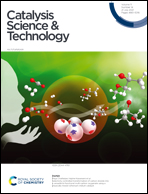Critical practices in conducting electrochemical conversion of 5-hydroxymethylfurfural†
Abstract
The electrochemical conversion of 5-hydroxymethylfurfural (HMF) into high value-added chemicals has attracted much attention. Owing to the complexity of the electrochemical process, there are many faulty operations and misleading results reported in the literature. The central objective of this work is to establish a vigorous assessment protocol for electrochemical conversion of HMF. To this end, two typical electrocatalysts, i.e., commercial Pt/C and nickel nanoparticles, are assembled on catalyst supports including glassy carbon electrodes, carbon paper and nickel foam. The catalytic activity and product distribution of HMF conversion using the electrodes are investigated. The effects of electrode preparation, HMF stability, pH values of the electrolyte, electrolyte impurities, cell configurations and product quantification on HMF conversion are systematically studied. The results show that HMF is unstable when the pH of the electrolyte is higher than 12 or lower than 2. The conversion of HMF is dependent on the properties of support materials, agitation of electrolytes, and the protective atmosphere of electrolytes. Notably, the presence of ppm-levels of impurities such as Fe3+, Cu2+ and Ni2+ in electrolyte solutions accelerates HMF electro-oxidation but shows limited effects on HMF hydrogenation. Notably, using Pt/C as a catalyst, a current density of 0.84 mA cm−2 is obtained at 1.6 V using the electrolyte with 5 ppm Cu2+, which is 3.5 times that resulting from using the electrolyte free of Cu2+. Four electrochemical cells including an undivided cell and H-type cells separated by a Nafion 117 membrane, anion membrane and salt bridge are evaluated for HMF conversion. When nickel foam is used as a catalyst support, the H-type cell with a salt bridge and the undivided cell are not suitable for HMF oxidation because of the cracking of the nickel foam. When the HMF concentration in the electrolyte is less than 20 mM, the H-type cell with a Nafion 117 membrane is more suitable for HMF conversion.



 Please wait while we load your content...
Please wait while we load your content...